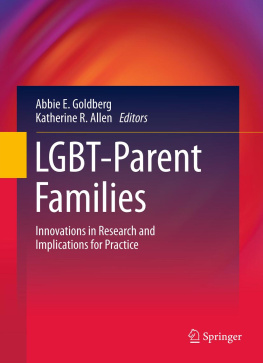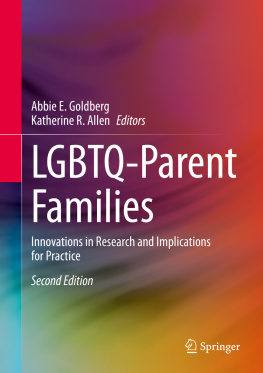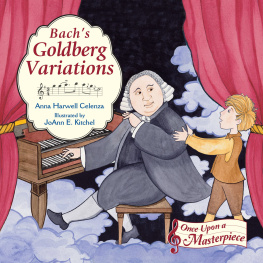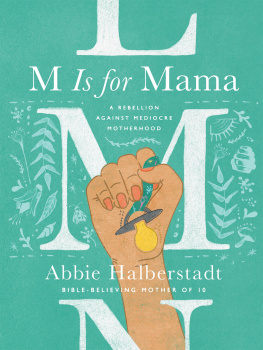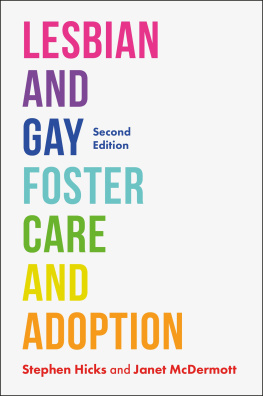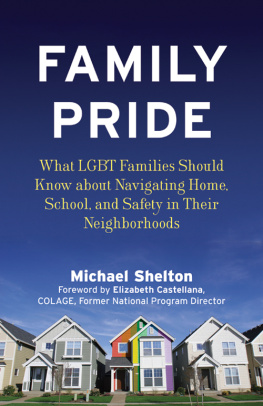Pioneering Lesbian and Gay Parenting
Lesbian and gay parenting after a heterosexual relationship ends in separation or divorce was established as a field of research in the 1980s. Most of our knowledge about whether or not parental sexual orientation influences childrens development is derived from studies of children raised by their lesbian mother and her new female partner after the childs mother and father separated. Lesbian and gay parenting post-heterosexual separation has not been a prominent topic in either published research or media headlines in recent years, as research interest has moved on to planned parenting by lesbians and gay men. Nevertheless, tantalizing questions of definition and fluidity both of sexuality and of parenting remain to be explored, and these are questions that speak to the heart of post-identity politics in a new era.
In reviewing the field I first contextualize lesbian and gay parenting post-heterosexual separation, noting difficulties of definition within our limited knowledge of the demographic profile of nonheterosexual parenting. Using U.S. Census data from 2000, Gates and Ost () have explained, the U.S. Census did not ask a direct question about sexual identity, sexual behavior, or route to parenthood, and would have missed single lesbians or gay men or those with non-cohabiting partners. The Census used traditional definitions of the ending of a heterosexual marital relationship in divorce and the formation of stepfamilythus confounding new partnership, co-residence, and stepparenting in presuming that a cohabiting same-gender partner would be involved in parenting and a non-cohabiting partner would not. Lesbian and gay parenting post-heterosexual separation does not necessarily fit traditional heterosexual patterns.
In the main body of this chapter I consider key published studies of lesbian and gay parenting post-heterosexual separation that have been undertaken, viewing them from a social constructionist position as situated within the sociohistorical context of various theoretical, legal, and social debates that have influenced the field. I have grouped the studies according to their thematic concerns: concerns about parental separation or divorce and child well-being, hearing the voices of lesbian and gay parents, coming out, and acknowledging new partners. To highlight both theoretical perspectives and methodological aspects of the studies reviewed, I also have noted the academic discipline most associated with each thematic grouping as this too has contextualized the research.
I conclude with a final section on new trends and future directions in which I consider an integrative perspective on the field, in particular drawing on the frameworks of life course theory (Bengtson & Allen, ). These perspectives highlight (a) the importance of improving definition and measurement in quantitative research, (b) the need to contextualize lesbian and gay parenting by investigating intersectionality, and (c) the significance of queering the field and speaking the unspoken.
Where possible, I have prioritized studies that collect data from lesbian and gay parents themselves, and considered the often hidden perspectives of their same-gender partners, rather than dwelling on the more numerous studies on the perspectives and experiences of the children raised in these families. Childrens perspectives are considered elsewhere in this volume (and see also Goldberg,
Concern About Parental Separation and Divorce: Influences from Child Psychology and Psychiatry
Clinicians working with children and their families were the first set of professionals to publish research on lesbian and gay parenting. Beginning in the 1970s and 1980s, papers by psychiatrists began to be published giving concise accounts of issues highlighted in case notes from individual sessions with lesbian mothers or gay fathers and their children. These papers tended to emphasize the difficulties children faced in lesbian- or gay-parent families post-heterosexual separation or divorce (Agbayewa, ). Authors contextualized many of the issues encountered as similar to those faced by other children of separated or divorced heterosexual parents who had begun new sexual relationships. This work opened the door to later empirical work using control groups of children brought up by a single heterosexual parent after parental separation or divorce.
Initial studies of same-gender parenting were launched largely by developmental psychologists and child psychiatrists to empirically investigate pragmatic concerns raised by divorce settlements in the 1970s and 1980s restricting residence and visitation by lesbian mothers (e.g., Golombok, ).
Studies also addressed theoretical questions on the influence of parenting on childrens social development, testing out theories that emphasized the importance for childrens development of having two resident parents of the opposite gender. Psychoanalytic theories emphasized the salience of the fathers active presence in helping to resolve oedipal dilemmas for both sons and daughters (Socarides, ). Psychoanalytic theories drew attention to the amount of contact children had with their father subsequent to parental separation as moderating the influence of upbringing by a lesbian mother. Social learning theories indicated the significance of how the mother responded to her childs preferences related to gender and psychosexual development. Social cognitive theories highlighted children as active agents in their own social development and the salience of peer group norms rather than parental sources.
Beginning in the early 1980s, studies were published that examined the family relationships of children of separated or divorced lesbian mothers by comparing parentchild relationships in a group of lesbian-led families with a group of families headed by a single heterosexual mother. These studies carefully matched participants characteristics between groups or statistically controlled for additional variables to rule out factors associated with the experience of parental separation or divorce. The most rigorous of these studies also used multiple measurements and independent reporters together with statistical techniques that calculated the probability of a finding being definitive beyond the particular sample that generated it (e.g., Golombok, Spencer, & Rutter, ).

